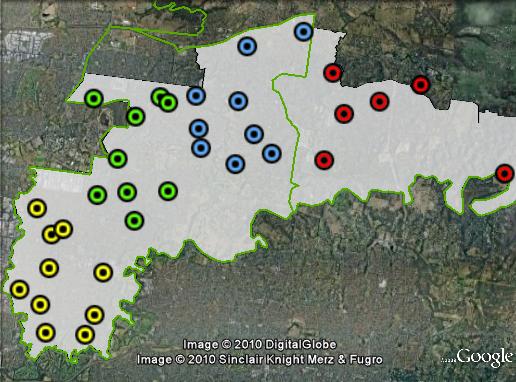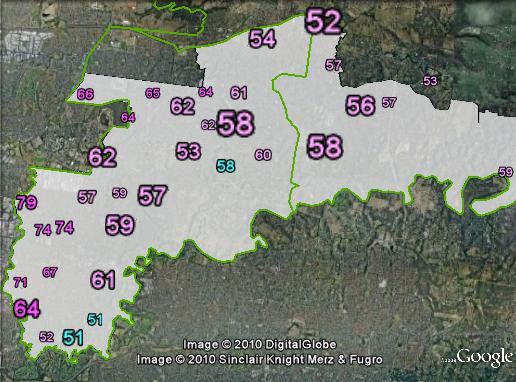ALP 9.0%
Incumbent MP
Jenny Macklin, since 1996.
Geography
North-eastern suburbs of Melbourne. Jagajaga covers most of Banyule council area and southern parts of Nillumbik council area. Key suburbs include Ivanhoe, Heidelberg, Eaglemont, Rosanna, Viewbank, Yallambie, Montmorency, Eltham, St Helena and Warrandyte.
History
Jagajaga was created for the expansion of the House of Representatives in 1984, and has always been held by the ALP.
Jagajaga was first won in 1984 by Peter Staples, who had previously won the seat of Diamond Valley at the 1983 election, before it was abolished in 1984.
Staples was appointed as a junior minister after the 1987 election, and served until a reshuffle in 1993, and served as a backbencher until his retirement at the 1996 election.
Jagajaga was won in 1996 by Jenny Macklin. Macklin served as a shadow minister for the entirety of the Howard government. She was Deputy Leader from the 2001 election until 2006, when she was defeated by Julia Gillard when Kevin Rudd defeated Kim Beazley for the party’s leadership. She has served as Minister for Families, Housing, Community Services and Indigenous Affairs since the election of the Rudd government in 2007.
Candidates
- Joe Sgarlata (Family First)
- Jenny Macklin (Labor) – Member for Jagajaga since 1996. Minister for Families, Housing, Community Services and Indigenous Affairs since 2007.
- Joh Bauch (Liberal)
- Chris Kearney (Greens)
- Peter Harris (Secular Party)
Political situation
This seat is relatively safe for the ALP, although the 9% margin isn’t huge considering the national Labor swing in 2007.
2007 result
| Candidate | Party | Votes | % | Swing |
| Jenny Macklin | ALP | 42,154 | 48.16 | +3.38 |
| Conrad D’Souza | LIB | 32,870 | 37.55 | -4.78 |
| Lisa Hodgson | GRN | 8,971 | 10.25 | +1.94 |
| Andrew Conlon | FF | 2,065 | 2.36 | +0.07 |
| Jason Graham | DEM | 979 | 1.12 | -0.03 |
| Stephen Lele | CEC | 496 | 0.56 | +0.38 |
2007 two-candidate-preferred result
| Candidate | Party | Votes | % | Swing |
| Jenny Macklin | ALP | 51,630 | 58.98 | +4.58 |
| Conrad D’Souza | LIB | 35,905 | 41.02 | -4.58 |
Booth breakdown
Booths in Nillumbik Shire have been grouped as “east”, while booths in Banyule have been grouped into the North West, South West and Central areas.
The ALP won a majority in all areas. They won around 55-7% in the central and eastern parts of the seat. They polled around 60% in the north west and 63.7% in the south west.

| Voter group | GRN % | ALP 2CP % | Total votes | % of votes |
| Central | 8.37 | 55.04 | 20,609 | 23.54 |
| South West | 11.32 | 63.68 | 18,192 | 20.78 |
| North West | 8.38 | 60.69 | 18,005 | 20.57 |
| East | 13.95 | 56.84 | 11,547 | 13.19 |
| Other votes | 10.78 | 58.45 | 19,182 | 21.91 |



The grouping of booths was a little tricky on this one. As you can see, the ‘South West’ group contains significant variation, from very strong Labor booths to booths won by the Liberals. There was no clear dividing line, and I didn’t want to split the seat up into too many small groupings, so I left them together.
There are some strong Greens votes in individual booths too. A 32% Senate vote at North Warrandyte was the best, and also over 20% at the Ivanhoe and Fairy Hills booths in that ‘South West’ area.
Or I should say, there was no good dividing line taking into account suburb boundaries, which is what I tried to stick to.
Interesting that Jagajaga would probably be a very competitive marginal seat if not for the Heidelberg West public housing estate where Labor racks up 70+% margins in a handful of booths.
Most of the rest of the seat is fairly typical marginal suburbia.
Apparently a lot of health and education employees in this seat also which helps the Labor vote. Probably more of a state issue but the Green/Labor Nillumbik council has become quite unpopular for their tree removal poicies in light of the bushfires
hey there, i believe that the therieos of liberal party are very unseccesful. i think we should have milk bars in every street so my family can do well.
My prediction: Labor retain, 2-3% swing to them.